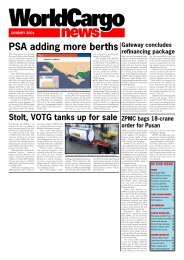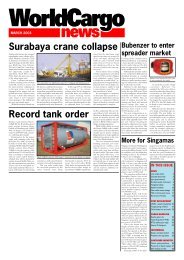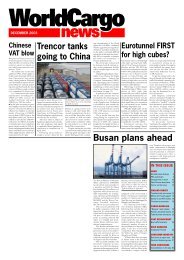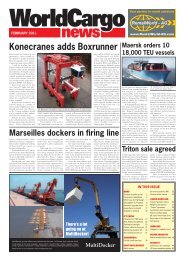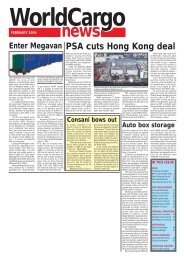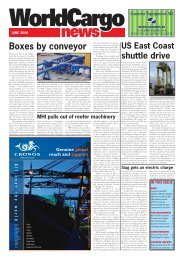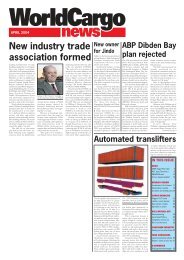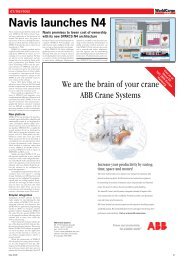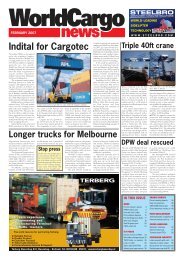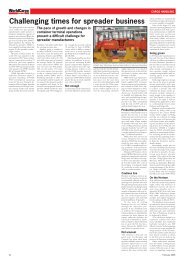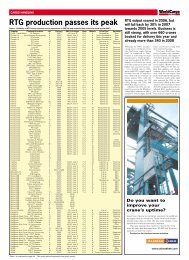US-built box crane - WorldCargo News Online
US-built box crane - WorldCargo News Online
US-built box crane - WorldCargo News Online
Create successful ePaper yourself
Turn your PDF publications into a flip-book with our unique Google optimized e-Paper software.
REEFER IND<strong>US</strong>TRY<br />
<strong>WorldCargo</strong><br />
news<br />
Reefer machinery builders scroll ahead<br />
Producers of reefer container machinery<br />
have rarely been as busy<br />
as in recent years as they have<br />
strived to meet a sizeable and sustained<br />
year-on-year growth in demand.<br />
Annual production of reefer machines<br />
has increased by almost 10 per cent on<br />
average during each of the past five years,<br />
boosting output from around 50,000 machines<br />
of maritime build in 1999 to almost<br />
80,000 last year (see Table 1). The<br />
forecast for 2005 is around 86,000, depending<br />
on the performance of the reefer<br />
industry during the final quarter.<br />
All four established reefer machinery<br />
producers - Carrier Transicold, Thermo<br />
King Corp, Daikin Industries and<br />
Mitsubishi Reefer - benefited from<br />
record orders during the opening half of<br />
2005, when over 45,000 units are reckoned<br />
to have been delivered.<br />
This longstanding quartet has been<br />
joined by a newcomer in the shape of<br />
Maersk Container Industri (MCI), which<br />
has carried out its first series manufacture<br />
of the new StarCool machine<br />
launched late in 2004 (see <strong>WorldCargo</strong><br />
<strong>News</strong> November 2004, p60). Around<br />
1500 units are due for construction this<br />
year at MCI’s reefer factory in Qingdao,<br />
all for sister company, Maersk Sealand.<br />
No third party sales are planned as yet,<br />
until the units are further field tested and<br />
a more comprehensive after-sales network<br />
has been established.<br />
Picking up<br />
Reefer demand only slackened slightly<br />
throughout the summer months, allowing<br />
manufacturers some time for staff<br />
breaks and routine maintenance, and it<br />
is expected to pick up again in the fourth<br />
quarter. In this respect, the refrigerated<br />
container market is currently holding up<br />
more strongly than its dry freight counterpart,<br />
while the outlook for reefer demand<br />
remains upbeat for 2006 as well.<br />
Output has been driven up most recently<br />
by shipping lines, which directly<br />
purchased roughly 70 per cent of all<br />
reefer <strong>box</strong>es produced in 2004, equivalent<br />
to over 55,000 units. They are expected<br />
to take an even higher share (75<br />
per cent or greater) in 2005.<br />
Production for leasing companies last<br />
peaked in 2003, with these buyers taking<br />
far fewer in the two years since. The<br />
inexorable shift towards the 40ft high<br />
cube reefer has continued as well, with<br />
over 85 per cent of all new machines now<br />
fitted into containers of this size. The<br />
balance goes for 20ft end-use. As such,<br />
there has long been a decreasing tendency<br />
on the part of some machinery<br />
suppliers to offer a separate 20ft model,<br />
while the former price differential (of a<br />
few per cent) existing between machines<br />
of 20ft and 40ft size has shrunk to almost<br />
nothing.<br />
Carrier still produces a specific 20ft<br />
model, while most other suppliers usually<br />
advise the fitting of their 40ft machinery<br />
to 20ft reefer bodies. This offers<br />
the benefit of a proportionally higher capacity<br />
rating, which is often desirable as<br />
20ft equipment is still predominantly<br />
used to carry deep frozen perishables,<br />
requiring high performing refrigeration.<br />
With close to 50 per cent of reefer container<br />
units now equipped with scroll compressors,<br />
and the recent scaling up of production,<br />
machinery prices have been forced down to<br />
their lowest level in many years<br />
Price drop<br />
Despite the strength of demand, machinery<br />
prices have generally fallen in recent<br />
years and are today at a very “competitive”<br />
level. Models of the most basic type<br />
can currently be acquired for less than<br />
<strong>US</strong>$8000, assuming a sizeable order run,<br />
and it is rare now to pay over <strong>US</strong>$8500-<br />
9000 for any design, even when various<br />
add-ons (such as controlled atmosphere)<br />
are included.<br />
This compares with the <strong>US</strong>$9000 or<br />
greater paid on average two or three years<br />
ago. Naturally the recent weak <strong>US</strong> dollar<br />
exchange has helped hold down the prices<br />
of some components, while the earlier reentry<br />
into the market by Daikin, plus the<br />
intensified competition existing between<br />
Carrier and Thermo King, have also<br />
played their part.<br />
The recent relocation of production<br />
by Carrier and Thermo King, respectively<br />
to Singapore and China, has further<br />
helped to force down manufacturing<br />
costs.<br />
Conversely, as the price of reefer machinery<br />
has fallen, the average cost of a<br />
refrigerated body shot up between 2003<br />
All over the world<br />
Antwerp<br />
Dubai<br />
Genoa<br />
Gothenburg<br />
Hamburg<br />
Hong Kong<br />
Lisbon<br />
London<br />
Madras<br />
New York<br />
Rio de Janeiro<br />
San Francisco<br />
Seoul<br />
Shanghai<br />
Singapore<br />
Sydney<br />
Taipei<br />
Tokyo<br />
and 2004, due largely to a sharp rise in<br />
the cost of stainless steel and foaming material.<br />
A 40ft high cube reefer of standard<br />
build increased by over <strong>US</strong>$1000 in<br />
the year to late 2004, to top <strong>US</strong>$9000,<br />
although this figure has since dropped<br />
back again to below <strong>US</strong>$8500.<br />
Scroll impact<br />
The increased uptake of “scroll-platform”<br />
machinery, which features a single<br />
scroll compressor in place of the more<br />
traditional reciprocating version, has also<br />
had an impact on finished machine<br />
prices. Scroll compressors have fallen rapidly<br />
in price as they have become more<br />
commonplace, while their operational efficiency<br />
has improved. The use of a scroll<br />
compressor can also cut machinery<br />
weight and dimensional size.<br />
Table 1: Summary of recent maritime<br />
reefer container machinery output<br />
Year Total R134a R404A Other*<br />
Units (%) (%) (%)<br />
1999 51,000 82.5 7.5 10.0<br />
2000 55,500 86.5 7.5 6.0<br />
2001 52,500 90,5 8.5 1.0<br />
2002 65,500 91.0 9.0 -<br />
2003 71,500 89.5 10.5 -<br />
2004 79,000 88.5 11.5 -<br />
2005** 86,500 87.0 13.0 -<br />
*Mainly R22. **Projected at third quarter<br />
A growing number of shipping lines<br />
have switched to specifying scroll com-<br />
Cronos Reefers<br />
A robust and corrosion-resistant design – with genuine global support<br />
• Featuring Carrier and Thermo King machinery<br />
• Construction materials to suit customer requirements<br />
• Maximum allowable cargo capacity<br />
• Long term warranties – up to 5 years<br />
• Available in 20', 40' and 40' High Cube<br />
• Available for master, operational and term lease or sale<br />
Contact your local Cronos office or visit<br />
www.cronos.com<br />
Global service support in all<br />
major port locations<br />
See us at<br />
Intermodal Transport<br />
& Logistics – Stand D48<br />
Bilbao, Spain<br />
8-10 November 2005<br />
September 2005 47



